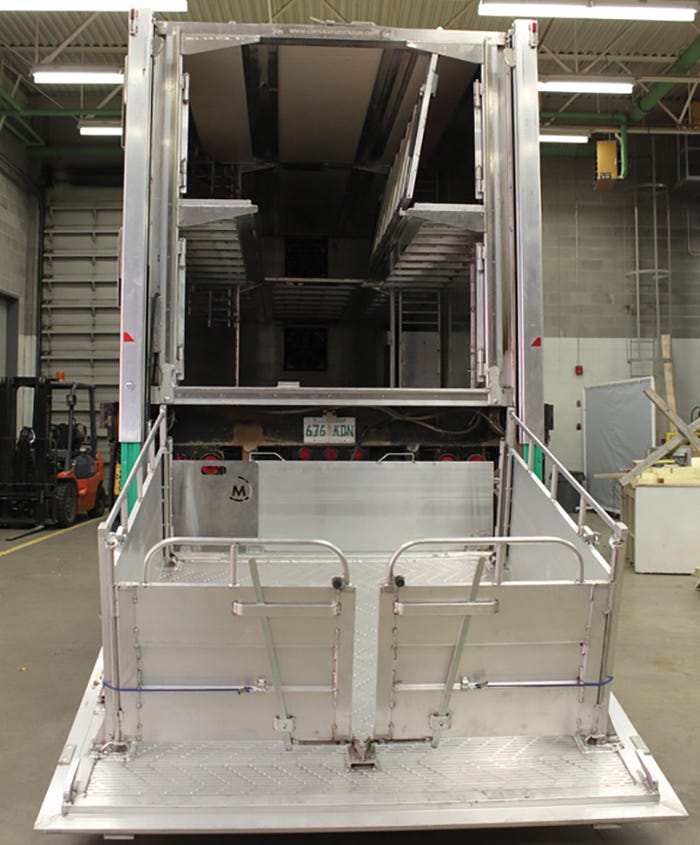Engineering a better ride
Researchers find prototype trailer reduces concentration of aerosolized model virus by 96.9%.
January 10, 2020

Keeping pigs comfortable in their pens and maintaining disease-free barns are top priorities for pork producers. Once those pigs hit the road, however, livestock trailer conditions often aren't as favorable for maintaining temperature, cleaning and loading, and enforcing biosecurity practices.
The livestock industry is not only facing growing consumer pressure to provide more welfare-friendly vehicles, livestock trailers have also been implicated as possible vectors for disease transmission among farms.
After a Canada-wide pork industry survey that addressed the need for better livestock transportation, research scientists with the Prairie Swine Centre set out to build a prototype air-filtered trailer.
Design parameters were gathered from the stakeholders' survey, and initial design configuration options were narrowed down using computer simulation. From there, a prototype air-filtered transportation trailer was born.
Design and ventilation
Using the commercially available computational fluid dynamics software Ansys, the engineers created a baseline case for latter comparisons with new trailer designs.
Simulation was done on a conventional straight-deck trailer (two decks with five compartments in the upper deck, and six in the bottom deck).
Six trailer design options were created, based on alternative locations and different numbers of air inlets and air outlets, which are the main drivers of air movement in mechanical ventilation systems. Each were evaluated in summer and winter conditions.
Top designs were selected based on ventilation effectiveness and the capability to meet the environmental requirement of pigs during transport. Heat removal effectiveness (HRE) was used to evaluate the ventilation effectiveness of each design option.
The best design configuration for the air-filtered trailer from simulations was implemented in the construction of the prototype trailer.
The performance of the air-filtered trailer was evaluated during stationary and road tests — specifically, its ability in preventing airborne pathogen introduction. The effectiveness of the ventilation system in providing an acceptable microclimate to pigs during transport was also examined.
Ask and receive
During the survey, three components emerged as the top concerns Canadian pork industry members have with commercial livestock trailers today: potential for disease infection via air due to open configuration, difficulty in loading and cleaning, and variable temperatures.
To address these concerns, the initial plan for the prototype trailer included design features such as incorporation of mechanical ventilation and air filtration systems; reduction or elimination of internal ramps and partitions; and having hinged floor panels to allow ease in loading and unloading pigs, and to facilitate cleaning.
Five of the six design options showed comparable range and mean values for HRE, temperature, moisture and air velocity at designated monitoring points in summer conditions.

Best design option
Taking into account both summer and winter simulation results, the trailer design that included one inlet opening on each side at the front area of the trailer and two air outlets on each side near the back of the trailer was selected as the best design option for subsequent sensitivity analysis.
The front compartment holds components of the trailer air filtration and ventilation systems, where a 10-kilowatt, single-phase generator sits, and an air filter wall was installed.
Two 18-inch-diameter fans were installed at the downstream side of the filters to pull fresh air through the bank of air filters and into the animal compartment. The flow rates for each fan were controlled using a commercially available, centralized ventilation control system.
The animal compartment included solid walls and two straight decks (divided by a gate into two compartments) that were 3 feet, 5 inches in height. The middle portion of the floor of the upper deck and trailer roof is hinged and can be lifted up to allow easier loading, unloading or other activities, such as trailer cleaning, inspection, etc.
To address animal handling and welfare issues arising from loading and unloading in the conventional livestock trailer, a 1,000-kilogram-capacity hydraulic loading platform was added in the prototype trailer.

Putting it to the test
Based on this design, the prototype trailer showed overall reduction of 96.9% in concentration of the aerosolized model virus (bacteriophage Phi X174) inside the animal compartment relative to upstream of the filter (minimum efficiency reporting value-8, or MERV-8, prefilter and MERV-16 main filter).
In addition, monitoring of two trips showed the mechanical ventilation system was able to maintain the desired thermal conditions within the animal compartment.
Moisture level and air quality inside the trailer during the monitored trips were maintained at levels comparable to conditions found inside swine barns.
A supplemental heating unit helped to ensure the animal compartment temperature did not go lower than 10 degrees C during the trips under winter conditions.
Events during the trip, such as slowing down or full stops, affected environmental conditions inside the trailer, although the desired conditions were quickly restored once the trip resumed.
Return on investment
A cost analysis of the air-filtered trailer prototype, which considered total equipment and installation cost as well as annual operational and filter maintenance costs, yielded a payback period of 2.1 years if a modest premium of $5 per pig is realized for transporting pigs using an air-filtered trailer.
From this first effort on design and development of major equipment, various points for optimization of the prototype have been identified to continue work to further improve trailer efficiency and to bring the overall trailer design closer to commercialization.
Researchers: Bernardo Predicala, Alvin Alvarado, Jingjing Cabahug and Shelley Kirychuk, Prairie Swine Centre at the University of Saskatchewan. For more information, contact Predicala.
You May Also Like



